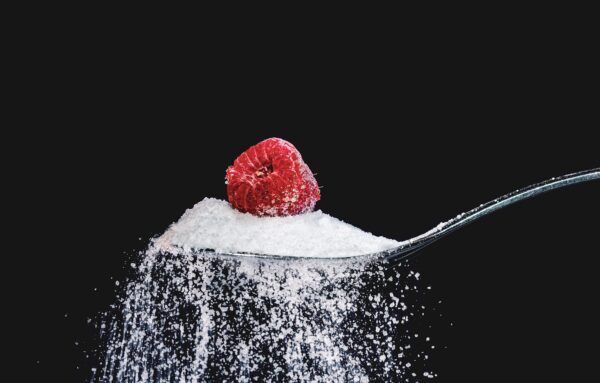
Three items recently spurred my interest in this subject. First, a month or so ago, my mother-in-law got a postcard from a realtor with a recipe for buckwheat pancakes on it. She planned to make them and showed it to me. “What’s this ‘no-carb sweetener’?” she asked. I had no idea. The recipe clearly wasn’t talking about some type of artificial sweetener that you use by the drop, as it called for something like a cupful. Hmmm. (But I did warn her that this was a vegan recipe, as it called for “flax eggs,” which you make by mixing ground flaxseed and water in proportions of 1:3 and letting the mixture sit for about 15 minutes. A perfectly good thing if you’re allergic to eggs, of course, and if you’re ethically opposed to animal products. But you don’t have to do it if you think that flaxseed is better for you than eggs. Just eat the eggs!) Anyway, I sort of forgot about the issue until I got my King Arthur Flour catalog in the mail and saw that they were selling something called “Baking Sugar Alternative.” Hmmm, again. I also found references online to what seemed to be the originating product, something called “PureCane.” On the packaging were the words “made from sugarcane,” thus implying that this was actually sugar, just without calories. What was this? I examined the ingredients for both the KAF and PureCane versions: the first one listed was “erythritol.” I knew immediately that this was one of the so-called “sugar alcohols,” a group of sweeteners that also includes sorbitol and xylitol. I may have mentioned before that I had a rather unpleasant experience once upon a time when I ate a whole roll of chocolate-mint Velamints, which are made with sorbitol. Hey, they were sugar free! What could it hoit? I will spare you the details, but I was left with a distinct aversion to this class of substances. The reason they can produce such after-effects is that they pass through the gut without being absorbed. Can anybody say “olestra”? That was the so-called “calorie-free fat” back in the day which was pulled from the market due to causing some very embarrassing episodes. Erythritol seems to be less of a problem than the other sugar alcohols, though, because of the way it works in the digestive system. Here’s a good representative quote:
Side effects. Eating lots of sugar alcohols can lead to bloating and an upset stomach. Some sugar alcohols can cause gas and cramping or work like a laxative when they reach your colon. But erythritol is generally mostly absorbed before it gets to your colon and is excreted unchanged in your urine. Excess gas and a laxative effect are possible, but people generally handle it better than other sugar alcohols, and it doesn’t come with any warnings.
For this specific sugar alcohol, here’s the suggested limit:
Most people can handle 1 gram for every kilogram of body weight daily. So if you weigh 150 pounds, you can tolerate 68 grams of erythritol a day, or more than 13 teaspoons.(both quotations from “What Is Erythritol?”)
So, great! Right! I can have 13 teaspoons of this stuff, or a little over double the recommended WHO limit of 6 teaspoons of regular sugar, and it’s all good! It won’t “count”!
To which I say, “Not so fast.” I reiterate here what I’ve said so many times before: Food is supposed to be food. It’s not supposed to be something you just ingest, for fun or entertainment. It’s ideally consumed only at meals. You eat it, you enjoy it, you hope it’s nutritious, and then you move on to the rest of your life until the next meal. You keep the sugar and other refined carbs under control. You don’t encourage your sweet tooth by continually feeding it with fake sugars.
Think I’m the only one who feels this way? Well, I’m not. Interestingly enough, today as I was thinking about this post I listened to one of my regular podcasts, “Milk Street Radio.” I’ll give the link below, and you can listen to the whole thing if you’d like to—it’s all very interesting. But the interview with a woman who tasted several alternative sugars—although not the ones I listed above, interestingly enough—came to sort of the same conclusion I have. She does raise a question that has concerned a number of nutritionists and other scientists, which is how the pancreas reacts to a sweet taste that has no calories. Does it pump out globs of insulin anyway? The answer seems to be no, at least for now. We’re just not sure how all this works. The interview lasts only a little over eight minutes, and you’ll learn a lot. It confirmed for me that, as the old Chiffon margarine ad used to say, “It’s not nice to fool Mother Nature.” And always remember two factors in this whole no-calorie-sweetener schemozzle:
- No calories from sugar doesn’t mean no calories at all. Cookies made with the KAF baking sugar still have flour, eggs, and butter. At least I hope they do!
- Using a sugar substitute tends to produce what’s called the “halo effect,” a concept I’ve discussed before. You think that because you ate sugar-free cookies you can then eat a bag of potato chips. As I’ve also said before, Americans are the only ones who think you can lose weight by eating
Okay. That’s enough for now. So far I’ve resisted the temptation to get freebies or special offers about PureCane, and I think I’ll continue to do so. (It’s pretty expensive, by the way.) Use the real stuff, but use it sparingly. Keep track of your sugar intake for the day. Stick to whole fruit for a main source of sweets. And throw out whatever it is in your pantry that’s tempting you!
Here’s the podcast:
“Frontiers of Food Science: Do Sound and Color Affect Flavor?”